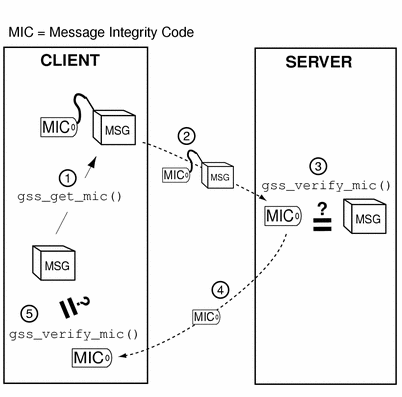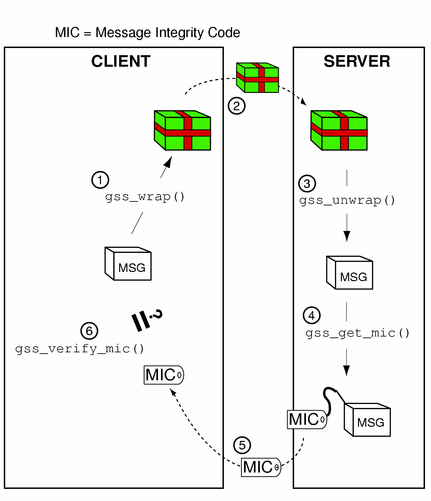Unwrapping and Verification
Once it has been received, a wrapped message must be unwrapped with gss_unwrap(). gss_unwrap() automatically verifies the message against the MIC that is embedded with the wrapped message. If the sender did not wrap the message but used gss_get_mic() to produce a MIC, then the received message can be verified against that MIC with gss_verify_mic(). In this latter case the acceptor must arrange to receive both the message and its MIC.
gss_unwrap()
OM_uint32 gss_unwrap ( OM_uint32 *minor_status, const gss_ctx_id_t context_handle, const gss_buffer_t input_message_buffer, gss_buffer_t output_message_buffer, int *conf_state gss_qop_t *qop_state)
- minor_status
-
The status code returned by the underlying security mechanism.
- context_handle
-
The context under which this message will be sent.
- input_message_buffer
-
The wrapped message. This argument must be in the form of a gss_buffer_desc object; see Strings and Similar Data. Must be freed up with gss_release_buffer() when you have finished with it.
- output_message_buffer
-
The buffer for the unwrapped wrapped message. After the application is done with the unwrapped message, it must release this buffer with gss_release_buffer(). This argument is also a gss_buffer_desc object.
- conf_state
-
A flag that indicates whether confidentiality was applied or not. If non-zero, then confidentiality, message origin authentication, and integrity services were applied. If zero, only message-origin authentication and integrity were applied. Specify NULL if not required.
- qop_state
-
The QOP (Quality of Protection) used. This is the cryptographic algorithm used in generating the MIC and doing the encryption. Specify NULL if not required.
gss_unwrap() returns GSS_S_COMPLETE if the message was successfully unwrapped. If it cannot verify the message against its MIC, it returns GSS_S_BAD_SIG.
gss_verify_mic()
If a message has been unwrapped, or if it was never wrapped in the first place, it can be verified with gss_verify_mic(). gss_verify_mic() looks like this:
OM_uint32 gss_verify_mic ( OM_uint32 *minor_status, const gss_ctx_id_t context_handle, const gss_buffer_t message_buffer, const gss_buffer_t token_buffer, gss_qop_t qop_state)
- minor_status
-
The status code returned by the underlying mechanism.
- context_handle
-
The context under which the message will be sent.
- message_buffer
-
The received message. This argument must be in the form of a gss_buffer_desc object; see Strings and Similar Data. Must be freed up with gss_release_buffer() when you have finished with it.
- token_buffer
-
The token containing the received MIC. This argument must be in the form of a gss_buffer_desc object; see Strings and Similar Data. This buffer must be freed up with gss_release_buffer() when the application has finished with it.
- qop_state
-
The QOP (Quality of Protection) that was applied in generating the MIC. Specify NULL if not required.
gss_verify_mic() returns GSS_S_COMPLETE if the message was successfully verified. If it cannot verify the message against its MIC, it returns GSS_S_BAD_SIG.
Transmission Confirmation (Optional)
After the recipient has unwrapped or verified the transmitted message, it might want to send a confirmation to the sender. This means sending back a MIC for that message. Consider the case of a message that was not wrapped by the sender, but only tagged with a MIC with gss_get_mic(). The process, illustrated in Figure 1–14, is as follows:
-
The initiator tags the message with gss_get_mic().
-
The initiator sends the message and MIC to the acceptor.
-
The acceptor verifies the message with gss_verify_mic().
-
The acceptor sends the MIC back to the initiator.
-
The initiator verifies the received MIC against the original message with gss_verify_mic().
Figure 1–14 Confirming MIC'd Data

In the case of wrapped data, the gss_unwrap() function never produces a separate MIC, so the recipient must generate it from the received (and unwrapped) message. The process, illustrated in Figure 1–15, is as follows:
-
The initiator wraps the message with gss_wrap().
-
The initiator sends the wrapped message.
-
The acceptor unwraps the message with gss_unwrap().
-
The acceptor calls gss_get_mic() to produce a MIC for the unwrapped message.
-
The acceptor sends the derived MIC to the initiator.
-
The initiator compares the received MIC against the original message with gss_verify_mic().
Figure 1–15 Confirming Wrapped Data

- © 2010, Oracle Corporation and/or its affiliates
